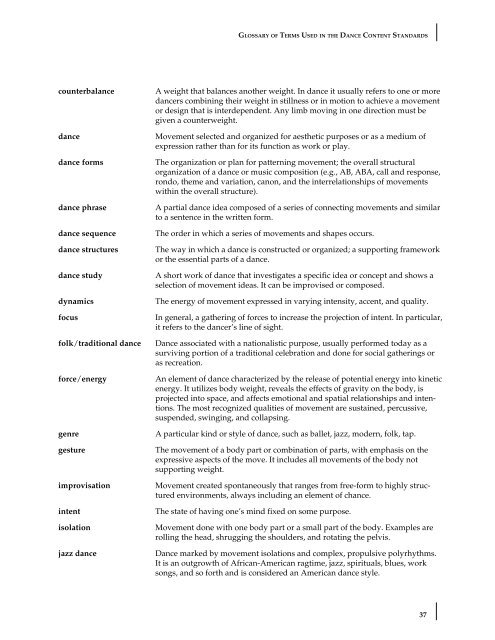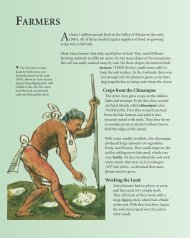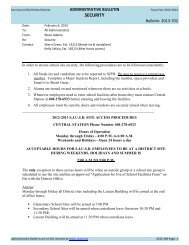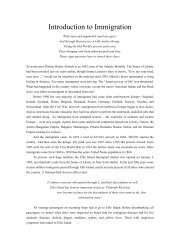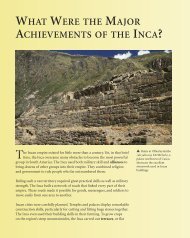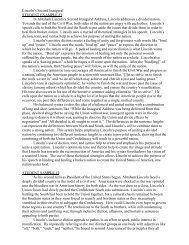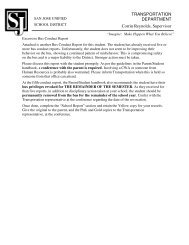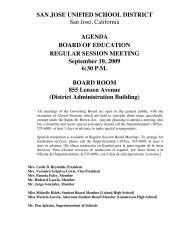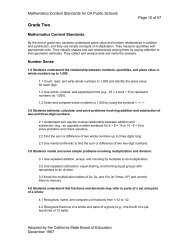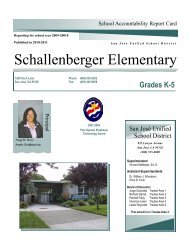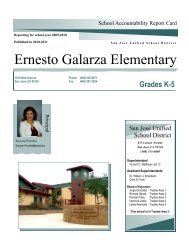Visual and Performing Arts Content Standards - California ...
Visual and Performing Arts Content Standards - California ...
Visual and Performing Arts Content Standards - California ...
You also want an ePaper? Increase the reach of your titles
YUMPU automatically turns print PDFs into web optimized ePapers that Google loves.
GLOSSARY OF TERMS USED IN THE DANCE CONTENT STANDARDS<br />
counterbalance A weight that balances another weight. In dance it usually refers to one or more<br />
dancers combining their weight in stillness or in motion to achieve a movement<br />
or design that is interdependent. Any limb moving in one direction must be<br />
given a counterweight.<br />
dance Movement selected <strong>and</strong> organized for aesthetic purposes or as a medium of<br />
expression rather than for its function as work or play.<br />
dance forms The organization or plan for patterning movement; the overall structural<br />
organization of a dance or music composition (e.g., AB, ABA, call <strong>and</strong> response,<br />
rondo, theme <strong>and</strong> variation, canon, <strong>and</strong> the interrelationships of movements<br />
within the overall structure).<br />
dance phrase A partial dance idea composed of a series of connecting movements <strong>and</strong> similar<br />
to a sentence in the written form.<br />
dance sequence The order in which a series of movements <strong>and</strong> shapes occurs.<br />
dance structures The way in which a dance is constructed or organized; a supporting framework<br />
or the essential parts of a dance.<br />
dance study A short work of dance that investigates a specific idea or concept <strong>and</strong> shows a<br />
selection of movement ideas. It can be improvised or composed.<br />
dynamics The energy of movement expressed in varying intensity, accent, <strong>and</strong> quality.<br />
focus In general, a gathering of forces to increase the projection of intent. In particular,<br />
it refers to the dancer’s line of sight.<br />
folk/traditional dance Dance associated with a nationalistic purpose, usually performed today as a<br />
surviving portion of a traditional celebration <strong>and</strong> done for social gatherings or<br />
as recreation.<br />
force/energy An element of dance characterized by the release of potential energy into kinetic<br />
energy. It utilizes body weight, reveals the effects of gravity on the body, is<br />
projected into space, <strong>and</strong> affects emotional <strong>and</strong> spatial relationships <strong>and</strong> intentions.<br />
The most recognized qualities of movement are sustained, percussive,<br />
suspended, swinging, <strong>and</strong> collapsing.<br />
genre A particular kind or style of dance, such as ballet, jazz, modern, folk, tap.<br />
gesture The movement of a body part or combination of parts, with emphasis on the<br />
expressive aspects of the move. It includes all movements of the body not<br />
supporting weight.<br />
improvisation Movement created spontaneously that ranges from free-form to highly structured<br />
environments, always including an element of chance.<br />
intent The state of having one’s mind fixed on some purpose.<br />
isolation Movement done with one body part or a small part of the body. Examples are<br />
rolling the head, shrugging the shoulders, <strong>and</strong> rotating the pelvis.<br />
jazz dance Dance marked by movement isolations <strong>and</strong> complex, propulsive polyrhythms.<br />
It is an outgrowth of African-American ragtime, jazz, spirituals, blues, work<br />
songs, <strong>and</strong> so forth <strong>and</strong> is considered an American dance style.<br />
37


